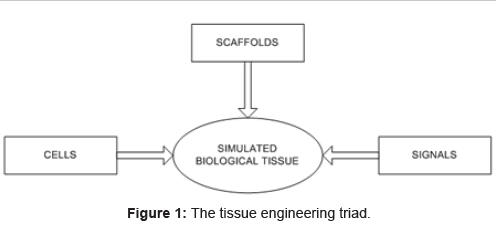Editorial Open Access
Biomimetic Scaffold Materials Used in Tissue Engineering
Elizabeth Kolos* and Andrew J RuysInstitute of Biomedical Engineering and Technology, AMME J07 University of Sydney 2006 Australia
- Corresponding Author:
- Elizabeth Kolos
Research Engineer
Institute of Biomedical Engineering and Technology
AMME J07 University of Sydney 2006 Australia
Tel: 0411097173
E-mail: Elizabeth.Kolos@hotmail.com
Received December 04, 2013; Accepted December 09, 2013; Published December 26, 2013
Citation: Kolos E, Ruys AJ (2013) Biomimetic Scaffold Materials Used in Tissue Engineering. J Biomim Biomater Tissue Eng 18:e101. doi:10.4172/1662-100X.1000e101
Copyright: © 2013 Kolos E, et al. This is an open-access article distributed under the terms of the Creative Commons Attribution License, which permits unrestricted use, distribution, and reproduction in any medium, provided the original author and source are credited.
Visit for more related articles at Journal of Biomimetics Biomaterials and Tissue Engineering
Tissue Engineering
Tissue engineering offers a novel route for repairing damaged or diseased tissue by incorporating the patient’s own healthy cells or donated cells into temporary scaffolds that act as a matrix for cell cultivation. The structure and properties of these scaffolds must be selected to ensure normal cell behaviour and performance of the cultivated tissue. The tissue scaffolds support cellular growth and activity both before implantation and during remodelling of surrounding tissue after implantation.
In tissue engineering, there are three components that the technologist must allow for to simulate biological tissue. These components are tissue scaffolds, cultivated cells, and cell signalling. These are represented in Figure 1.
Tissue scaffolds should be made with biocompatible materials which are biologically inert materials. This is characterised by the scaffold material eliciting a minimal inflammatory response.
A tissue scaffold provides a three-dimensional structure for the ingrowth of cells. In order to encourage vascularisation it is important to develop scaffolds with suitable pore size and distribution as well as interconnected porous channels. This allows for both cell attachment and cell ingrowth.
Scaffolds may be permanent or biodegradable. The scaffolds developed should exhibit scaffold degradation at a rate suitable for the specific tissue-type regeneration. A well-defined biodegradation rate is ideal so that host tissue can replace the scaffold and that stress can be transferred from the support scaffold to the new tissue over an appropriate time period.
The cells to grow on a tissue scaffold can be derived from cultivated tissue or those from stem cells. Stem cells can be derived from various sources including mesenchymal stems cells and embryonic stem cells. Mesenchymal stem cells, derived from adult bone marrow, are capable of differentiating into bone, cartilage, muscle, bone marrow stroma, tendon/ligament, fat, dermis and other connective tissue. Embryonic stem cells, derived from human blastocysts, are capable of differentiating into many cell types and may be potentially capable of developing into all cell types.
Cell signalling can be aided by the use of differentiation factors or specific receptors that improves cell signalling pathways.
Biomimetic Scaffold Materials
Biomimetic materials are an option as a scaffold material used in tissue engineering.
Biomimetic materials are designed to replicate one or more attributes of a material that mimics a process that exists in nature. Biomimetic materials share characteristics with biomaterials in that they serve to restore natural function where the original material is absent or unable to perform properly.
Biomimetic materials can be designed for a specific tissue type, that is, for either hard or soft tissues within the human body. Scaffolds that match the mechanical properties of the tissue type they are replacing are preferred.
Hard tissue scaffolds may be a replacement for autogenous cancellous bone grafts in patients who require repair to bone defects. Bone grafts are commonly used in the repair of bone trauma, in tumour resection and in spinal fusions. The challenge for tissue engineering for hard tissue is mechanical stability in load bearing applications.
Examples of bone tissue scaffolds include titanium alloys, biodegradable polymers, fibrous material scaffolds, glass-ceramic tissue scaffolds, alumina, and calcium phosphate materials.
Soft tissue scaffolds are already commercially available for skin. Traditionally skin grafts were used to deal with skin trauma caused through burns or other skin diseases. However where large areas of skin has been damaged, synthetic skin can be developed using tissue engineering. Other soft tissue scaffolds may be replacements for myocardium, blood vessels, skeletal muscle, adipose tissue, and even cartilage. The challenge for tissue engineering for soft tissue is that the soft tissues usually have large volumes, have high cell densities, and can be mechanically active.
Examples of soft tissue scaffolds include naturally occurring materials such as extracellular matrix and synthetic polymeric materials, or a composite material such as biodegradable polymer with bioactive ceramics.
One example of a composite material for either hard or soft tissue scaffold is a biomimetic material produced using a biomimetic coating technique. The biomimetic coating technique mimics the osteogenesis mechanism. This technique employs a soaking solution, simulated body fluid (SBF), the same ions that are present in blood plasma. It is the ratio of calcium and phosphate ions in this soaking solution that enables the technique to mimic the osteogenesis mechanism. This biomimetic coating technique produces a biologically active bone-like apatite layer that is similar to the apatite formed on the surfaces of bioactive ceramics when they have been placed in contact with blood in the living body.
In summary, biomimetic scaffold materials can be produced from a vast interpretation by mimicking processes that exist in nature and applied to tissue engineering for specific tissue type. Biomimetic scaffold materials incorporated with cells and cell signalling, known as a simulated biological tissue, can be implanted for tissue engineering.
--Relevant Topics
Recommended Journals
Article Tools
Article Usage
- Total views: 15509
- [From(publication date):
specialissue-2014 - Aug 24, 2025] - Breakdown by view type
- HTML page views : 10775
- PDF downloads : 4734

